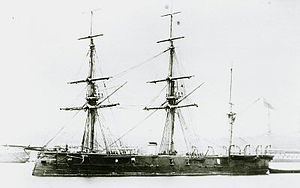Name HMS Research Cost £71,287 Completed 6 April 1864 Construction started 3 September 1861 Length 56 m | Laid down 3 September 1861 Commissioned 6 April 1864 Launched 15 August 1863 | |
 | ||
HMS Research was a small ironclad warship, converted from a wooden-hulled sloop and intended as an experimental platform in which to try out new concepts in armament and in armour. She was launched in 1863, laid up in 1878 and sold for breaking in 1884, having displayed serious limitations as a warship.
Contents
Background
In the period from 1860 to 1865 the Board of Admiralty were seriously concerned at the speed with which France was producing ironclad warships. One of the steps taken to counter this perceived threat was the conversion of partially built British wooden ships into ironclads, including such large ships as the Prince Consort-class ironclads.
Conversion
The 17-gun sloop Trent had been ordered in November 1860 as one of the Camelion-class. She was selected for conversion to an ironclad, and her name was changed to Research. Although she had been building for a year, work was not far advanced, and the necessary changes to her length and beam could easily be made. A new design by the Royal Navy Chief Constructor, Sir Edward Reed, saw her sloop ends replaced by an oval stern and a ram bow, and the draught altered to give her a trim of 3 1⁄2 feet (1.1 m) by the stern.
Armament
Her armament was carried in a midships armoured compartment which, when used in subsequent designs, became known as a box battery. The designed armament of seventeen guns was discarded, and the offensive power of the ship was concentrated into four 100-pounder Somerset smoothbore cannon, which were at the time the most powerful guns afloat. While these guns were certainly much more effective against armour than smaller pieces, whether a two-gun broadside would have prevailed against more generously armed ironclads is open to question.
For the first time, in this ship, a degree of axial fire was possible from broadside guns. The hull sides were recessed at either end of the battery, and gunports were constructed facing fore and aft to which the guns could be moved. Moving the guns in anything other than calm weather was a hazardous procedure.
The Somerset smoothbore cannon were replaced in 1870 with four 7-inch (180-mm) 6½-ton muzzle-loading rifles, largely because of the difficulty in working and controlling the guns.
Armour
Once completed as an ironclad, she featured a full-length 4 1⁄2-inch (11 cm) armour belt to a depth of 10 feet (3.0 m). An armoured box battery was provided on the main deck with the same thickness of armour. The iron armour was backed by 19 1⁄2 inches (50 cm) of teak.
Propulsion
Research was fitted with a 2-cylinder Boulton and Watt horizontal single-expansion direct-acting steam engine of 200 nominal horsepower. Steam was provided by two tubular boilers, and the screw, which was 12 feet (4 m) in diameter, could be hoisted clear of the water for better performance under sail. The total power of 937 indicated horsepower (699 kW) (after a refit in 1869 this was increased to 1,040 ihp) was sufficient to propel her at just over 10 knots (19 km/h). She carried 130 tons of coal.
Construction
Having been laid down on 3 September 1861, approval was given for her conversion to an ironclad on 1 September 1862. She was launched from Pembroke Dockyard on 15 August 1863 and commissioned on 6 April 1864.
Assessment
Research rolled excessively, and was normally retained in harbour during the winter months. Although Edward Reed, her designer, had expected great things of her, the Standard of 27 October 1865 said "probably the very worst vessel, both as a fighting machine and a sea-boat, that ever yet went out of a dockyard of any nation pretending to a maritime reputation".
Service
She served in the Channel Fleet from 1864 to 1866, and in the Mediterranean from 1871 to 1878.
In January 1868, while on patrol duties at the south coast of Ireland, she grounded near Cork Harbour while giving chase to an American ship, Alaska. During the subsequent court martial it was demonstrated that the ship had not in fact grounded on Daunt Rock, but instead on the wreckage of the steamer City of New York, which had wrecked near the rock a year previously, and the ship's officers were exonerated.
Fate
She was laid up in 1878 and sold for breaking in 1884.
